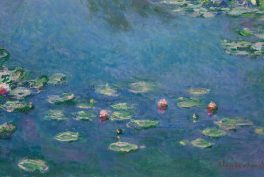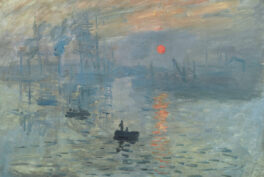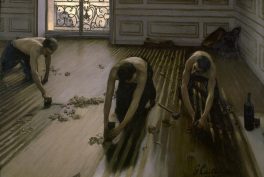1. Impressionism in a Jar
We remember that the intention of the Impressionist painters was not to narrate a subject, but to capture the instant, to convey a certain atmosphere. This is why Claude Monet chose such an every day and apparently unimportant subject as a jar of peaches. But precisely its mastery lies in its simplicity.
This subject was painted in 1866 when Impressionism was not yet at its peak and Monet was still searching for his way of expression. For Monet, the theme is just an excuse to experiment with the optical phenomena of light through colors. The jar of peaches is placed to the left side, it does not occupy the central part. Monet plays with the reflection of light on the jar, but at the same time, he represents its reflection on the marbled base. He also makes a great play of textures: the glass of the jar, the delicate and soft skin of the peaches, and the fabric covering of the jar opposing the cold veined marble.
2. Fine China, Peaches, and a Melon
The French artist selects summer fruits such as peaches and a melon and places them carefully to offer us a perfect vision. The bright orange of the fruits contrasts with the delicate Chinese porcelain, so precious at the time. Monet shows us his mastery through the shadows: of the porcelain and the ones in the interior of the melon, the brilliance of the grapes, or the folds of the white tablecloth.
It should be noted that this magnificent still life was executed the same year as the Impression, Sunrise, a pioneering work in the development of Impressionism.
3. A Famous Breton Dessert
Monet was definitely a foodie and a gourmet! Behold these magnificent cookies! Don’t they make you want to eat them? If you did not know, galettes are a typical dish of the Breton region of France, where Monet stayed between February and April 1882. Perhaps as a tribute to the region, he created this sweet work.
The Impressionist style is evident, both in the treatment of light and in the free and loose brushstroke. The artist uses once again warm tones such as browns and oranges, both for the sweets and the vase. Together with the soft natural light, he manages to transmit a “homey” and “cozy” atmosphere. Perhaps the only dissonant element is the sharp knife.
4. Just a Branch of Lemons
This small branch of lemons is a prime example of Claude Monet’s Impressionist style. In 1884, after a trip to the Italian region of Bordighera, Monet fell deeply in love with the lush vegetation of the region, especially with the lemon trees.
The bright yellow hue of the lemons creates a deep contrast to their opposite color, blue. The free, loose, and bold stroke superimposes the color on the painting.
If you enjoyed this selection of Claude Monet’s still life paintings, be sure to check our Food & Drinks Postcards, which also feature, among others, Monet’s still lifes.











